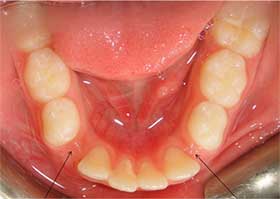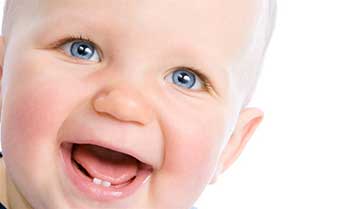CHILDREN'S DENTAL HEALTH (PEDODONTİCS)
The formation of teeth commence in the mother’s womb. After the birth, the first deciduous teeth (also known as primary teeth, temporary teeth, baby teeth or milk teeth) erupt during 6-10 months and the dentition period starts, which lasts up until approximately 2.5 years. In about two years 20 deciduous teeth take their place within the mouth. Until the child is 6 years old, only these 20 deciduous teeth will be present in the mouth. This period is called as deciduous (primary) teeth period.
There are 5 deciduous teeth in each quadrant as upper right, upper left, lower right and lower left. Two of these are incisors, one is canine tooth and two are primary molars.
As the deciduous teeth take their place within the mouth, the permanent teeth placed underneath the roots of the primary teeth continue their maturation stage, awaiting the time for their eruption. Just like a seed waiting for the appropriate season to emerge into daylight, each tooth seed will move in the alveolar bone and take its place within the mouth when the maturation has been completed.
The status of the mouth in a five year old kid
Deciduous teeth have taken their place, the permanent teeth placed on their root tips are maturating
When the child reaches 6 years of age, the first permanent teeth erupt. This tooth also named as six year tooth is the first permanent molar and remains in the mouth during the rest of the lifetime. Due to the fact that it erupts without reducing any deciduous teeth and its rear position, it is rarely noticed by the parents and interpreted as a deciduous tooth. In upper and lower jaws, the sixth tooth starting from the middle is the six year tooth, in other words the first molar tooth. It is not a deciduous tooth, it is a permanent tooth and perhaps the most precious one that has to maintain its place within the mouth during the complete lifespan...
Starting from 7 years of age, deciduous and permanent teeth commence replacing each other. Permanent teeth which mature within the alveolar bone cause the roots of the deciduous teeth to resorb and make their way into the mouth. The deciduous teeth with their resorbed roots start to loosen and fall out, or else they are easily extracted.
During this period which is observed approximately between 7-13 years, deciduous and permanent teeth are seen together in the mouth. This period is named as mixed dentition period. At the end of 13 years all primary teeth have fallen out leaving their place to permanent teeth. From now on the permanent teeth period has started which will last a whole lifetime.
The fact that deciduous teeth remain in the mouth for a temporary period and their place is filled with permanent teeth after extraction/falling out makes the parents think that primary teeth are of no significance. Most of the time the caries of deciduous teeth are not treated with the notion of ‘Somehow or other, it will fall out’, but this is a big error. Each deciduous tooth is a place maintainer for the permanent tooth that will take its place and should definitely remain in the mouth until the eruption of the permanent tooth starts. For example if a deciduous tooth which will be replaced at 12 years of age is extracted when the child is 8 years, then that area will remain empty for four years. During these four years, neighboring teeth will move into that empty area and the permanent teeth which will be ready to erupt will not be able to find sufficient space and try to erupt from the adjacent areas.

Lower deciduous canines have been extracted prematurely and their space has been closed
No space has been left for permanent canine teeth to erupt
Upper deciduous canines have been extracted prematurely and adjacent teeth have closed the gaps
Permanent canines were not able to find adequate space to erupt and have erupted from the front area
Upper and lower deciduous canines have all been extracted prematurely,
adjacent teeth have moved in and closed the gap
In this case the permanent canines underneath couldn’t find a place to erupt and have erupted outwards.
A serious orthodontic problem has occurred.
Premature deciduous teeth loss is the most important cause of teeth crowding and orthodontic disorders. Deciduous teeth with dental caries should absolutely be cured, if necessary root canal treatment should be performed. All deciduous teeth should remain in the mouth until they are ready to be replaced by permanent teeth. In other words, the transition of primary-permanent teeth should take place naturally and spontaneously, at the right time. This timing is different for each tooth.
Timetable for deciduous teeth / Eruption and fall out
If a deciduous tooth has been prematurely extracted due to necessities, then its place should be protected with simple space maintainers and the closure of this gap should be hindered until the eruption of the permanent tooth lying underneath.
Space maintainer application is the easiest way to prevent possible orthodontic disorders and long lasting orthodontic treatments
One of the most frequently encountered problems in children is the baby bottle tooth decay. A common application in order to make babies fall easily asleep, is to feed them milk with baby bottles at night. It is expected that the baby falls asleep during bottle feeding. But as a result of adding sweeteners such as sugar, honey or molasses to the milk, these substances prepare an adequate environment for extensive tooth decay. With the reduction of saliva secretion during sleep these substances adhere to the teeth forming acid until morning and tooth decays become inevitable.
The worst aspect of baby bottle tooth decay is that the teeth decay altogether
Sweeteners should not be added to the milk and the action of making the baby fall asleep with the bottle should be abandoned.
Babies should be acquainted with the tooth brush starting from the eruption of their first tooth, it should be provided that they adopt to the toothbrush which they initially regard as a toy. Of course during this period their teeth should be brushed by the parent, additionally the teeth should be cleaned with a clean cloth wrapped on the index finger. Teeth should be thoroughly washed after consumption of decay forming substances such as sweets, chocolate etc. It is not of vital importance how much chocolate the child consumes daily, but how soon the teeth are brushed after consumption and how long these substances contact the teeth.
The child should grow seeing his parents brush their teeth regularly. Tooth brushing habit starts as an imitation and game. One of the requirements of being a good parent is to succeed in endearing the tooth brushing game to the kid. Parents who can’t achieve this unfortunately have to witness their kid struggling with tooth problems for all their lives.


The information contained in the site is to inform about dentistry and treatment methods.
This information is definitely not a substitute for the physician to examine the patient for medical purposes or to make a diagnosis.